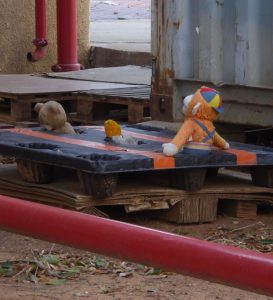
Okay.
I admit it.
I don’t know.
Does the activity I’m sharing here fall under the label of “Promoting Critical L2 Reading Strategies”?
The activity focuses on one very specific negative reading strategy that some of my struggling Deaf and hard-of-hearing high school students tend to rely on, one which I wish I could eradicate completely…
Is this activity a good stepping stone on the road to reading for understanding or just a simple “review this before the exam” activity?

I’m not sure.
But I know whom to ask!
I am going to take full advantage of the fact that an expert on the topic, Joyce Kling from Lund University will be speaking at the upcoming ETAI 2023 International Conference & Mediterranean Symposium.
Full advantage means that in addition to attending Joyce Kling’s talk on “Supporting Students’ L2 Critical Reading Strategies”, I plan to approach her during one of the breaks and follow up with a few questions regarding activities that are broken down specifically for struggling learners such as the one in this post.
You can do that at Face-to-Face conferences.
You really can go up to speakers, introduce yourself, and talk to them. Even if you meet them waiting in line for coffee!
Or at the bus stop – I’ve had fascinating conversations with both teachers and speakers on the bus to or from a conference!
See you there!
—————————————————————————–
The LOOK ALIKE Trap

No pictures, videos, or creative games for this activity.
I needed a direct, no-frills approach, to highlight my point this time.
Using the word “trap” seemed to awaken a competitive streak in some of the students. I told the students that the people who write their exams know that some students have a system for answering multiple-choice questions on reading comprehension tasks. A system that doesn’t require reading. These students simply look for words that look alike in the options and in the text and then choose their answer without further investigation. For example:
| The Sentence from the Text | The Wrong Answer |
| 1. Mr. Jay invested 11 million dollars in the football team. | X Mr. Jay earned 11 million dollars from the football team. |
Such students see the words “11 million dollars” and fall blithely into the trap the exam writer has set. The distractor that “looks-alike” is the wrong one (“Duh”, my strong students would say, but this is not for them)!
So, in this activity, I challenged the students to outsmart the exam writers and not fall into the “look-alike” traps that had been set for them.
Together we examined 8 sentences, which I modified from actual national exams (so as to make them clearer when being read out of context) along with corresponding incorrect answers chosen by unknown students who had fallen into the “traps”.
Vocabulary wasn’t an issue – I supplied any “glosses” needed.
The fact that the students were able to analyze the errors successfully with hardly any guidance on my part (mainly glossing or adding context) didn’t mean the activity was too easy.
Quite the opposite.
They seemed to feel empowered. They could avoid a trap! They weren’t going to lose 8 points over nothing!

Naomi’s Photos
Here is the worksheet I used. The downloadable document contains two versions – one with the “critical” words underlined, and the other with no hints whatsoever. I used the version without any words underlined.
***Remember – this is not a worksheet for self-study. It is the discussion that matters. I was even able to sneak in a reminder about superlatives…